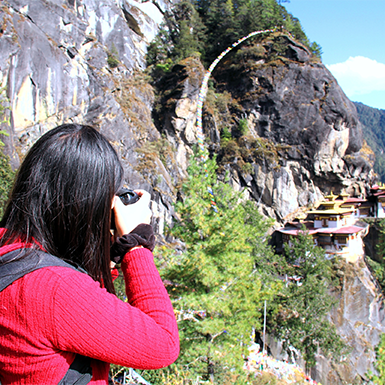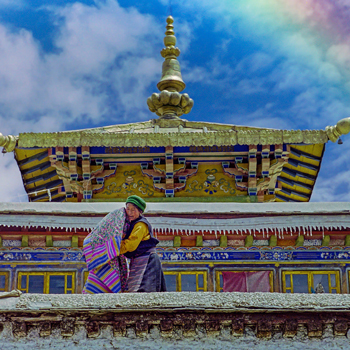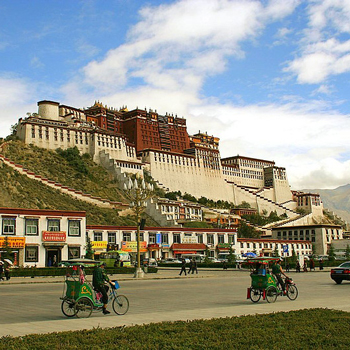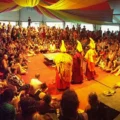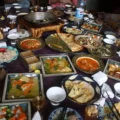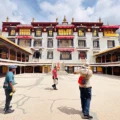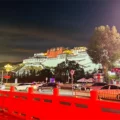Nestled amidst the dramatic Tibetan plateau, Gyantse (sometimes referred to as “Gyaltsen” or “Second Lhasa”) unveils a tapestry of history and culture unlike any other. This ancient city pulses with a unique energy, beckoning travelers seeking an authentic Tibetan experience.
A Glimpse into Gyantse’s Glorious Past
Gyantse’s rich past stretches back centuries. Once a flourishing center on the trade route between Lhasa and India, the city prospered as a commercial and cultural hub. Evidence of this glorious era abounds. Magnificent monasteries, the imposing Dzong (fortress), and traditional dwellings lining the streets all whisper tales of a bygone era.
Cultural Tapestry on Display
Gyaltsen’s significance transcends its historical importance. The city serves as a vibrant showcase of Tibetan culture. Spiritual history and a creative legacy are everywhere you look, from the elaborate murals that cover the monastery walls to the vibrant prayer flags that fly in the breeze.

Unveiling Gyantse: A City Steeped in History and Culture
Gyaltsen, a captivating city nestled amidst the Tibetan plateau, boasts a rich past that intertwines with Tibet’s broader history. This Gyaltsen travel guide delves into the city’s historical significance, offering a deeper understanding of its architectural wonders, cultural traditions, and unique character.
A Crossroads of Commerce and Faith
Gyantse’s strategic location along the historic trade route between Lhasa and Shigatse fueled its rise as a prominent commercial center. From the 14th century onwards, merchants from across Asia converged here, fostering a vibrant exchange of goods and ideas. The city’s architecture and traditions reveal this influence, creating a captivating blend that distinguishes Gyaltsen.
Key Events That Shaped Gyaltsen
Several key historical events shaped Gyaltsen into the city it is today:
- 14th Century: They built the imposing Gyantse Dzong, using it as a military stronghold and administrative center.
- 15th Century: They constructed the sprawling Pelkor Chode monastery complex, establishing it as a significant pilgrimage site for Tibetan Buddhists.
- 18th Century: The majestic Kumbum stupa, the largest stupa in Tibet, is erected within the Pelkor Chode complex, further solidifying Gyaltsen’s religious significance.
- 19th Century: The influence of British and Chinese expeditions leads to the construction of new forts and trade routes, impacting the city’s landscape.
A Center of Tibetan Buddhism
Gyaltsen played a prominent role in Tibet’s religious history. The presence of the Pelkor Chode monastery complex, with its numerous chapels and sacred relics, reflects the city’s deep devotion to Tibetan Buddhism. The colossal Kumbum stupa is a testament to the region’s reverence for Buddha and his teachings.
Unveiling Gyantse’s Treasures: Must-See Attractions
Gyantse Dzong (Fortress): A Sentinel Steeped in History
The imposing Gyantse Dzong, or Dzong Fortress, towers over Gyaltsen, embodying a formidable structure that tells the tales of the city’s rich past. Constructed in the 14th century, the Dzong functioned as a military stronghold and an administrative center. Its thick walls and strategic location provide insight into its significance as a critical defensive point.
Architectural Grandeur and Breathtaking Vistas
While exploring the Dzong, admire its intricate architecture, which showcases the skill of Tibetan builders. Ascending to the higher levels provides panoramic views of the city, allowing you to appreciate its layout and the surrounding landscapes.
Pelkor Chode Monastery and the Kumbum Stupa: A Spiritual Sanctuary
A short walk from the Dzong lies the Pelkor Chode monastery complex, a sacred site for Tibetan Buddhists. Here, the magnificent Kumbum stupa dominates the landscape. This massive whitewashed stupa, the largest in Tibet, enshrines holy Buddhist relics and displays captivating murals depicting Buddha’s life scenes.
Delve into the Details: Thangkas and Statues
Within the Pelkor Chode complex, explore the labyrinthine corridors lined with countless chapels. Each chapel houses exquisite Tibetan Buddhist artwork, including intricate thangkas (painted scrolls) and serene statues depicting various deities. Take your time to appreciate these objects’ craftsmanship and deep spiritual significance.
A Step Back in Time: Exploring Gyaltsen Old Town
Gyantse Old Town offers a captivating glimpse into traditional Tibetan life. Wander through narrow alleys lined with houses built in the vernacular style. These dwellings, constructed from stone and wood, often feature intricately carved doorways and colorful prayer flags fluttering in the breeze.
Witness Local Life Unfold
As you explore Old Town, look for locals going about their daily routines. You might encounter vendors selling traditional Tibetan handicrafts or witness monks draped in maroon robes making their way to prayer. This vibrant atmosphere allows you to experience its unique culture firsthand.
Unveiling Gyantse’s Cultural Tapestry: Experiences Beyond Monuments
Gyaltsen comes alive during its annual festivals, pulsating with energy and offering a chance to witness Tibetan culture in all its glory. A standout event is the Gyantse Horse Racing Festival, held in summer. Watch skilled riders compete in exciting races while traditional music and dance performances enhance the atmosphere. This festival provides a window into the Tibetan people’s nomadic heritage and deep connection with horses.
Treasures Crafted with Tradition
Gyaltsen proudly maintains a rich arts and crafts tradition that has been passed down through generations. Explore the Old Town and discover skilled artisans creating beautiful objects using techniques honed over centuries. Look for items like:
- Thangka Paintings: These intricate hand-painted scrolls depict Buddhist deities and scenes.
- Tibetan Carpets: Woven from yak or sheep wool, these carpets feature vibrant colors and intricate designs.
- Turquoise Jewelry: In Tibet, artisans often use prized turquoise to create stunning necklaces, bracelets, and earrings.
By purchasing these handicrafts, you acquire a unique souvenir and support the preservation of its artistic heritage.
A Taste of Gyantse: Culinary Delights
Cultural exploration is only complete with indulging in the local cuisine. Gyaltsen offers a variety of dishes that reflect the region’s unique ingredients and cooking styles. Here are some must-try specialties:
- Momo: These steamed dumplings are a staple Tibetan food, filled with meat or vegetables.
- Yak Meat Stew: A hearty and flavorful dish, perfect for the cool Tibetan climate.
- Chang: A local barley beer with a slightly sweet taste, often served during celebrations.

Practical Tips for Your Journey
Planning Your Visit: When to Go
Gyaltsen offers a captivating experience year-round, but some seasons provide distinct advantages. Here’s a quick breakdown:
- Spring (April-May): Pleasant weather with clear skies, ideal for sightseeing. However, spring can be windy, and nights can be chilly.
- Summer (June-August): The warmest time to visit, with vibrant festivals like the Gyantse Horse Racing Festival. Afternoon rain showers are shared.
- Autumn (September-October): Clear skies return, offering stunning views. Temperatures become more relaxed, so pack layers.
- Winter (November-March): The coldest season, with potential snowfall. Accommodation options and tourist services may be limited.
Finding Your Place to Stay
Gyantse offers a range of accommodation options to suit all budgets:
- Budget: Guesthouses and hostels provide basic amenities at affordable prices.
- Mid-Range: Comfortable hotels with good facilities are readily available.
- Luxury: A few high-end hotels offer exceptional service and amenities.
Getting There and Getting Around
Gyaltsen conveniently lies between Lhasa and Shigatse. Here’s how to reach the city:
- From Lhasa: You can join a pre-booked tour or take a taxi or car along the Friendship Highway. The trip takes roughly 2-3 hours.
- From Shigatse: Buses and taxis connect Shigatse to Gyaltsen in about 2 hours.
In the old town of Gyaltsen, you can easily walk to most Gyantse attractions. For longer distances, hiring a taxi is an option; remember to negotiate the fare beforehand. Alternatively, for a more adventurous way to explore, consider renting bicycles.
Additional Tips:
- Permits: Foreign visitors require a Tibet Travel Permit to enter Gyantse. Obtain this through a travel agency before your trip.
- Altitude: Gyaltsen is at a high altitude (over 3,900 meters). To avoid altitude sickness, acclimatize properly in Lhasa before visiting.
- Respectful Exploration: When you visit monasteries and temples, dress modestly and observe the local customs and traditions.
Dive Deeper: Interactive Experiences in Gyaltsen
Gyantse goes beyond sightseeing, offering unique opportunities to connect with its culture truly:
- Become a Monk for a Day: Some monasteries in Gyaltsen allow visitors to participate in morning prayers alongside monks. Witness their rituals and experience the tranquility of a Buddhist practice firsthand.
- Market Adventures with a Local Guide: Explore the bustling Gyantse market alongside a local guide. Learn about traditional Tibetan products, from prayer wheels to hand-woven carpets. The guide can help you navigate bargaining and ensure a respectful shopping experience.
- Cooking Class: Unveiling Culinary Secrets: Take a cooking class and learn to prepare traditional Tibetan dishes like momos (steamed dumplings) and yak butter tea. It’s a fun way to discover the flavors and culinary heritage of Gyaltsen.
Guided Tours: Unveiling Hidden Gems
There are many advantages to taking guided tours with knowledgeable locals:
- In-depth Historical Insights: Gain a deeper understanding of Gyantse’s fascinating past as your guide brings historical sites and stories to life.
- Cultural Nuances Explained: Acquire knowledge about regional practices, conventions, and manners to guarantee a considerate visit.
- Hidden Gems Revealed: Discover lesser-known sights and experiences beyond the typical tourist path, such as traditional workshops or local festivals.
Additional Tips for a Respectful Visit
- Dress modestly, especially when visiting monasteries.
- Respect local customs and etiquette.
- Always ask for permission before taking photographs of people.
- Honor the sacredness of religious sites.
Essential Information for a Smooth Visit to Gyantse
Before you start your Tibetan adventure, make sure you have all the practical details covered:
- Visa Requirements and Permits: To visit Gyaltsen, foreigners need a Tibet Travel Permit. You usually get this permit through a travel agency that organizes your Tibet tour, and you must also have a valid Chinese visa.
- Health and Safety at High Altitudes: Gyantse sits at a high altitude (over 3,900 meters). Be aware of altitude sickness and take steps to acclimatize properly. Drink plenty of fluids, avoid strenuous activity upon arrival, and rest if you experience headaches or dizziness.
- Currency and Communication: The official currency in China is the Renminbi (RMB), also known as the Chinese Yuan. ATMs are available in Gyaltsen, but carrying some cash in RMB is recommended. Mandarin Chinese is the primary language, but basic English phrases can be helpful.
- Bridging Cultural Differences: Tibetan culture embraces deep-seated traditions and etiquette. Dress modestly, especially when visiting monasteries. Be respectful of religious practices and seek permission before photographing people. A smile and a courteous gesture go a long way!
A Guide to Sustainable and Responsible Tourism
Gyaltsen is a captivating ancient city nestled in Tibet. It boasts a rich tapestry of history, culture, and breathtaking landscapes. This Gyantse travel guide goes beyond the must-see attractions, offering insights into how visitors can explore responsibly and contribute to the city’s well-being.

Protecting a Timeless Legacy
Gyaltsen architectural marvels, sacred monasteries, and time-honored traditions represent a shared heritage. Here’s how you can be a responsible traveler and help preserve this legacy:
- Respectful Exploration: When you visit monasteries and temples, ensure you dress modestly and respect local customs and traditions. Keep your noise level low and refrain from touching religious artifacts.
- Support Local Businesses: Opt for locally owned guesthouses, shops selling handcrafted souvenirs, and restaurants serving traditional cuisine. This directly benefits the community and fosters cultural preservation.
- Minimize Waste: Reusable water bottles are a great alternative to single-use plastics. Gyaltsen has few facilities for managing waste, so it’s important to dispose of waste properly.
Empowering the Local Community
Tourism plays a vital role in Gyantse’s economy. Here are ways to make your visit have a positive impact:
- Hire Local Guides: Knowledgeable local guides offer unique insights into Gyaltsen’s history and culture while their earnings directly support the community.
- Purchase Local Crafts: Souvenirs crafted by local artisans are beautiful keepsakes and a source of income for these skilled individuals. Look for shops that showcase traditional techniques and sustainable materials.
- Support Community Projects: Research and consider supporting initiatives that promote education, environmental conservation, or cultural preservation in Gyaltsen.
Travel Green: Eco-Friendly Practices for Gyaltsen
Gyantse’s natural beauty is a treasure to be cherished. Here are some tips for minimizing your environmental impact:
Minimize Energy Consumption: Turn off lights and electronics when not in use. Opt for shorter showers, considering the region’s water scarcity.
Reduce Water Waste: Conserve water by refilling your reusable water bottle instead of purchasing new plastic ones.
Travel Responsibly: Consider joining group tours or using public transportation to reduce your carbon footprint. Explore Gyaltsen on foot or by bicycle whenever possible.
Real Travelers Share Their Experiences
Gyaltsen, a Tibetan gem steeped in history and culture, offers an unforgettable experience for travelers. But what exactly makes it so unique? This Gyantse travel guide features captivating narratives from real travelers who share their experiences and recommendations to help you plan your adventure.
A Trip through Time: Sarah’s Encounter with History
“Gyaltsen felt like stepping back in time,” marvels Sarah, a history buff from California. “Exploring the labyrinthine corridors of Pelkor Chode monastery, I was captivated by the intricate thangkas and towering statues. The views from the Gyantse Dzong were breathtaking, offering a glimpse into the city’s strategic importance.”
Cultural Immersion: David’s Exploration of Tibetan Life
“Gyantse wasn’t just about monuments,” shares David, an avid traveler from Australia. Local artisans mesmerized me as I explored the Old Town by creating beautiful handicrafts.
Festival Fever: Mark’s Experience at the Gyantse Horse Racing Festival
“The energy at the Gyantse Horse Racing Festival was electric!” exclaims Mark, a photographer from England. “Witnessing the skilled riders competing in traditional garb, surrounded by vibrant music and dance, was a sensory overload in the best way possible. It was a truly unique cultural experience.”
Beyond the Guidebook: Insider Tips from Real Travelers
These travelers offer valuable insights to enhance your Gyaltsen visit:
Sarah: “Be sure to haggle gently at the shops in the Old Town. It’s part of the cultural experience!”
David: “Try some Tibetan momos! These steamed dumplings are a delicious and affordable local treat.”
Mark: “Pack plenty of layers if you’re visiting during the colder months. Particularly at night, there can be dramatic temperature drops.”
A Timeless Tibetan Treasure Awaits
Gyantse, a captivating city nestled amidst the Tibetan plateau, offers a unique blend of history, culture, and breathtaking scenery. This Cultural guide to Gyantse has equipped you with the knowledge to navigate this ancient city, explore its architectural marvels, and delve into the rich tapestry of Tibetan traditions.
More than Just Monuments: A Cultural Tapestry
Gyaltsen transcends the typical tourist destination. While the Gyantse Dzong and Pelkor Chode monastery with the Kumbum stupa offer a glimpse into Tibet’s architectural brilliance, the true magic lies in experiencing the vibrant culture. Witness the skill of local artisans crafting traditional handicrafts, savor the flavors of regional cuisine, and engage in the energy of festivals like the Gyaltsen Horse Racing Festival.
A Gateway to Tibetan Culture
Gyantse serves as a gateway to a deeper understanding of Tibetan culture. Interacting with the warm and welcoming locals, witnessing their religious practices, and appreciating their artistic expressions provide a unique perspective on this fascinating region.
Plan Your Unforgettable Gyaltsen Adventure
Gyantse welcomes you with open arms, eager to share its stories and traditions. Whether you are a history buff, a culture enthusiast, or an adventurer seeking a unique destination, it has something to offer everyone. Use this comprehensive guide to plan your trip, embrace responsible tourism practices, and start an unforgettable journey into the heart of Tibet.

